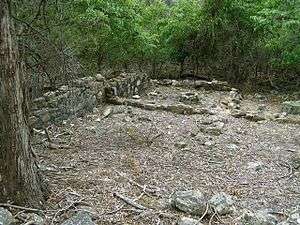Bittangabee Bay
Bittangabee Bay is a tiny, picturesque bay on the rugged and remote stretch of coastline south of Eden in New South Wales, Australia. The bay is located in Ben Boyd National Park, and there is a campground nearby.[1] The facilities are maintained by National Parks and Wildlife Service (NPWS), Merimbula office.[2] It can be reached by an unsealed road from the Princes Highway. The bay is the only haven between Twofold Bay and Mallacoota Inlet, and passing yachts are seen anchored for the night there most evenings. It is fed by Bittangabee Creek.
History

Bittangabee Bay has a known history for the indigenous people of the region, and significant early European settlement.[3]
Bittangabee Bay was known as 'Pertangerbee' by the original occupants of the area, the Thaua/Thawa/Thauaira people of the Yuin (Murring) nation, who have lived here for over 6,000 years. It was an important camp place and teaching ground, possibly a men's area, as Bundooro, one of the aboriginal names for Green Cape, was a teaching area for young men, and believed to be a men's area.[4] Naa-chi (now Nadgee Nature Reserve), on the other side of Green Cape to Bittangabee Bay, is the resting-place of their Rainbow Serpent, the most important totem of most Australian aboriginal people.
The Aborigines retain strong traditional and spiritual links to the land, and people in the National Park Service wish to maintain a collaborative relationship with Koori people, acknowledging their cultural beliefs and themselves adopting a philosophy of custodianship of this beautiful part of NSW.
The stone ruins at the bay date from 1844. In 1977, Kenneth McIntyre suggested the ruins were of Portuguese origin, and this romantic notion quickly established credence before it was ultimately proven incorrect by historian Michael Pearson.
Green Cape Lighthouse
The derelict stone storehouse at Bittangabee Bay is the only standing building within 6 kilometres (from the lighthouse and beach houses at Wonboyn), and was where supplies for Green Cape Lighthouse were left to be collected, until a passable road was built. Bittangabee Bay is the nearest safe anchorage to Green Cape Lighthouse,[5] built in 1881, and it is where the building materials and supplies for the lighthouse were landed, and then carted overland to the lighthouse. A wooden jetty and storeroom were built at Bittangabee Bay in 1881 by Albert Aspinall, a stonemason and builder, who won the contract to build the lighthouse. Aspinall then took five months to construct a seven kilometre-long wooden tramway through the forest and heathland to connect Bittangabee with Green Cape, when he could then commence building the light tower and houses. Materials and supplies were transported Bittangabee to the lighthouse site on wooden trolleys pulled by horses.
References
- ↑ "Bittangabee Bay". New South Wales National Parks and Wildlife Service. Retrieved 29 November 2013.
- ↑ DECC | Visiting a park Archived September 5, 2007, at the Wayback Machine.
- ↑ DECC | Visiting a park Archived July 27, 2008, at the Wayback Machine.
- ↑ Lighthouses of Australia Inc Bulletin 4/2004 - July/August 2004 Archived May 16, 2008, at the Wayback Machine.
- ↑ Lighthouses of Australia Inc Bulletin 4/2004 - July/August 2004
Coordinates: 37°12′54″S 150°00′57″E / 37.2149°S 150.0157°E